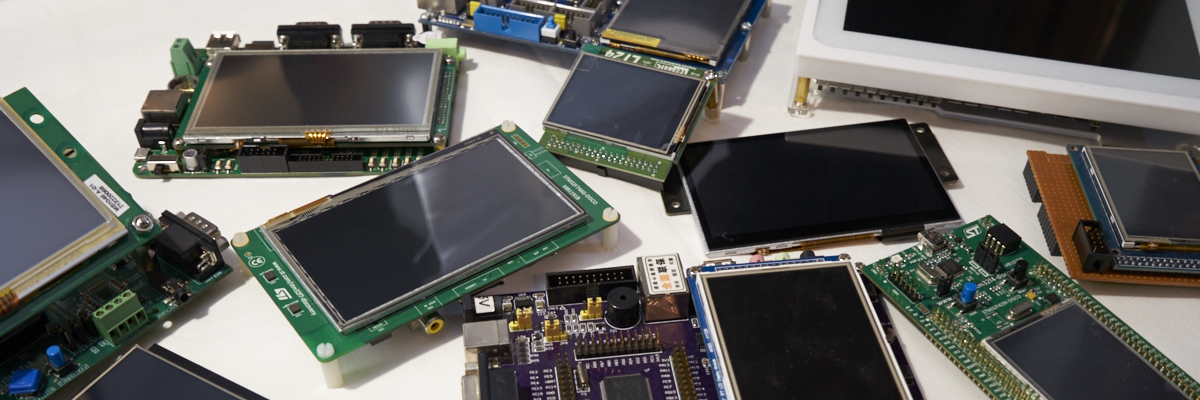-
Posts
2,659 -
Joined
-
Last visited
-
Days Won
2
Content Type
Forums
Store
Downloads
Blogs
Everything posted by Joel Bodenmann
-
That is a bug that got resolved a very long time ago. Please use the very latest version of the µGFX library (the master branch from the git repository). You can always just download it as a ZIP archive if you don't want to use git. Your change is not a proper fix. Your touchscreen will not be working now.
-
Hello Alan, First of all I'm glad to hear that you managed to resolve the issue. I completely forgot about the different heap managers that FreeRTOS has to offer. We should add that to our troubleshooting list. Regarding the images: All µGFX image decoders are streaming decoders which means that you never need to have the entire image in memory. Caching the decoded image is optional too so the memory usage is very minimal (but depends on the image format you're using). For example, when you render a BMP that is in your microcontrollers flash (using ROMFS) then you really only need a few dozen bytes for the image header (the gdispImage structure).
-
Hello Alan, I was referring to the stack size of the uGFX_task task. At some point in your program you have to start that task by either using the FreeRTOS API (such as xTaskCreate()) or by using the µGFX wrapper named gfxThreadCreate(). You either tell those functions how much stack you want to reserve for that task and they allocate it for you or you create the stack yourself and just point to it. In any case, make sure you're not experiencing a stack overflow caused by a stack that is too small. A side note: Keep in mind that FreeRTOS uses numbers of words for the stack size: http://www.freertos.org/FAQMem.html#StackSize
-

Deterministic periodic display glitch on STM32F7xx LTDC driver
Joel Bodenmann replied to nathanwiebe's topic in Support
Hello Nathan, This is a very interesting problem. We've never encountered this before. We ran some tests ourselves yesterday with a quite sophisticated µGFX application on an STM32F746G-Discovery board. Unfortunately, we were not able to reproduce the problem. Are you able to reproduce the problem on an STM32F746G-Discovery board? I don't want to point with fingers at someone, but let's start at the things that are easiest to check: Did you have a look at the errata of your microcontroller? I remember that one of the first STM32 that featured the LTDC had a bug that caused some artifacts on higher-resolution displays. Again: I'm not saying this is the case here, it's equally likely that the bug is in the µGFX driver but things like that are just easier to check when getting started to investigate. Also, what version of the µGFX library are you using? There was a datatype fix four months ago: I don't think that this has any impact here but again - let's start with the things that are simple to check The above is just an addition to what @inmarket wrote. -
Did you ensure that your thread stack is big enough?
-
Hello @Linker and welcome to the µGFX community! Can you please tell us what "won't work" means? What exactly are you experiencing? Compiler errors (if so, which ones)? Does it compile but the screen stays blank? Please give us more information.
-
Your custom rendering routine seems fine. That definitely shouldn't be a problem. I can't find any problem in the rest of your code either. Can you please use your debugger to grab a stack trace to figure out what causes the crash? Also, check whether it really is a crash. a "freeze" could also just being stuck in a loop waiting for something. Again, using the debugger will give you more information.
-
Please take that advice. Everything else is just getting you further down the rabbit hole. You might get it "working" eventually but then you'll have a non-standard version of the µGFX library which means that you can't just update to a newer version in the future that will contain bug fixes and new features. Furthermore, when you proceed with your project and you start adding other peripherals and so on you might end up getting the same lock-up again and that time you can't just modify µGFX sources to bypass the problem.
-
Those are µGFX library projects. They have nothing to do with the µGFX-Studio. They were written without using the µGFX-Studio.
-
You talk about icons. Did you write some custom widget? Are you using an existing widget with a custom rendering? Are you using existing widget code completely unmodified? Can you provide a minimum test case that allows us to reproduce the problem? Did you try to reproduce the problem when running your µGFX GUI on Windows, Linux or some other desktop system? Did you even try to debug the problem? Did you check for stack overflows? What kind of crash are you getting?
-
Hello @Asaliii and welcome to the µGFX community! That really sounds like a bug in your software. That's definitely unexpected behavior. Disabling the touchscreen is a very ugly work around that won't solve your problem in the long run. I'd rather encourage you to fix the problem you're actually having. Can you tell us more about your code?
-
Hello Fabien & welcome to the µGFX community! The Framebuffer board file prints very verbose error messages to stderr in case of something went wrong. Did you check your stderr for any output?
-
@inmarket is correct. The gwinImageOpenGFile() function takes a pointer to a GFILE. You can find the corresponding API reference here: http://api.ugfx.io/group___image_box.html#gab097ccfd4e1bcb9000ad5e563ff59ef3
-
We are happy to help wherever we can but you have to tell us what questions you have. Get started by getting µGFX running and then playing around with the various demos in the /demos directory before you start implementing your custom widgets.
-
I'm not sure what you mean by "write this". If you don't use external SDRAM then you don't need that code.
-
Hi Alan, No, that just means that you use some state of the library after the official 2.7 release. Please just do as I told you and grab the latest master branch from the git repository here: https://git.ugfx.io/uGFX/uGFX If you never worked with git or you don't want to get into it, you can always just download a ZIP archive of the latest state: https://git.ugfx.io/uGFX/uGFX/archive/master.zip
-

I need help with 256*64 OLED Based on the SSD1322 controller
Joel Bodenmann replied to zaher's topic in Support
Hi, Copying the existing SSD1306 driver is definitely the right thing to do. Maybe it would also be a good idea to ask @Andrey_13 to share his working SSD1322 driver. Explanation of the files in the driver directory: SSD1306.h: A file containing helper macros to access registers board_SSD1306_template.h: A template for the board file. The user of the driver needs to copy this file to his project (or board directory) and implement the functions inside. This is documented in the µGFX documentation. driver.mk: The makefile that includes the necessary files and paths in the main µGFX Makefile (it appends to the GFXINC and GFXSRC variables). gdisp_lld_ssd1306.c: The file with the actual driver implementation. gdisp_lld_config.h: Driver specific configuration options readme.txt: A readme file. Don't hesitate to ask if you have any specific questions. -
Yes, you can do all of that with the µGFX library. Of course things like that circular process circle doesn't exist yet but you can easily create a custom widget. Everything you need to do that already exists. Things like texts, images and buttons and so on are already there out of the box. Is this a hobby project or a commercial project? Already that would have a big impact on what you'd use. My personal recommendation (at this point, without knowing more information about your project and your goal) is to take the latest ChibiStudio and start playing with the STM32F746G-Discovery demo. Once you feel comfortable working with ChibiOS you can add µGFX. There's a guide in our wiki that explains how to add µGFX to an existing ChibiStudio project. It's straight forward.
-
In my post I wrote that the gwinDetachToggle() function is not in the current release. Please use the latest master branch of the µGFX repository:
-
Don't hesitate to ask if you have any questions. We're happy to help wherever we can!
-
Well, both ChibiOS 2.x and µGFX are very well tested. Of course there are bugs in both but the problems you're describing definitely aren't caused by that but simply by faults on you're side. I understand that the ChibiOS people told you to use v3 instead because nobody would want to support old software. I wouldn't want to support any µGFX 1.x question either. It really depends on what you want to achieve. Either get v3 working or find & fix the issue you're having with v2. Moving to v3 is definitely the better idea. However, you seem to be quite inexperienced. That can "annoy" you as well as the people trying to help you. Unless this is some project with a deadline I'd recommend you to grab the STM32F407-Discovery project from the latest ChibiOS and work from there. Adding µGFX to Chibios is very easy as you can just add the µGFX makefiles to the ChibiOS makefile as shown in the documentation. When doing that, make sure that you disable everything (including the GDISP) module in the µGFX configuration file (gfxconf.h). This way you wont have to deal with the display driver and display board file stuff yet. After adding µGFX your basic ChibiOS project should still be working. Once you're there, enable the GDISP module and add the drivers. That will require enabling the I2C1 and PWMD4 peripherals of ChibiOS.
-
What kind of problems did you run into? Are they µGFX related? I haven't worked a lot with ChibiOS 3.x but back in the days I worked a lot with ChibiOS 2.x. I don't expect 3.x to be any less good. The quality is very good. Actually, the µGFX library started off as a ChibiOS-only extension named ChibiOS/GFX. ChibiOS is probably the best supported underlying system by µGFX.
-
Then please follow the advice given in my post above and you should be able to succeed. Start by making sure that you have a ChibiOS project that works well without any problems. Then add, µGFX as per the documentation. Once µGFX is working add the display stuff. That last step will require to enable I2C1 and PWMD4 in the ChibiOS mcuconfig.h file.
-
I meant taking the mcuconf.h (or the entire project) from an existing STM32F407VGT-Discovery project from ChibiOS 3.0 (one that just flashes an LED) and then adding the stuff necessary. Have you ever worked with ChibiOS before? Adding µGFX to an existing ChibiOS project is really straight forward. But you definitely need to know what peripherals are and so on.
-
Can you please just take the STM32F407VGT-Discovery board file supplied by ChibiOS 3.x and enable the stuff that is used by the µGFX board file? We don't use anything but I2C1 and PWMD4. Everything else is "default" stuff (PAL (GPIO) and FSMC). I created the ChibiOS 2.x project myself. I'm 100% certain that it works. I'm not sure where the ChibiOS 3.x project comes from. But changes on the HAL stuff are minimal. You should definitely be able to get this working by just enabling I2C1 and PWMD4.

